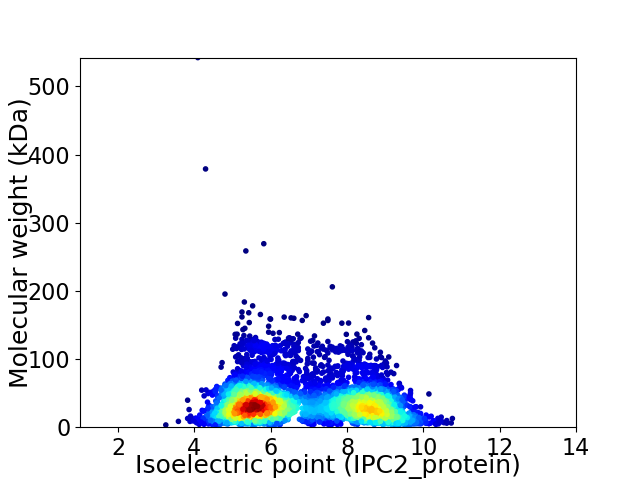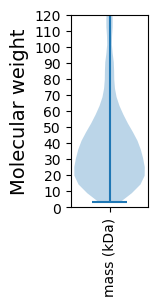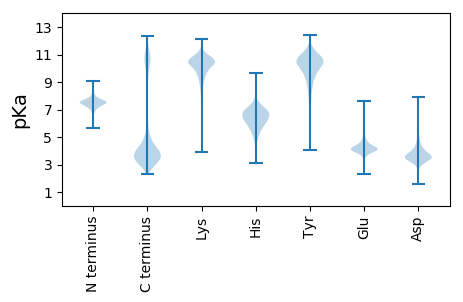
Sphingobacterium sp. (strain 21)
Taxonomy: cellular organisms; Bacteria; FCB group; Bacteroidetes/Chlorobi group; Bacteroidetes; Sphingobacteriia; Sphingobacteriales; Sphingobacteriaceae; Sphingobacterium; unclassified Sphingobacterium
Average proteome isoelectric point is 6.82
Get precalculated fractions of proteins

Virtual 2D-PAGE plot for 5132 proteins (isoelectric point calculated using IPC2_protein)
Get csv file with sequences according to given criteria:
* You can choose from 21 different methods for calculating isoelectric point
Summary statistics related to proteome-wise predictions



Protein with the lowest isoelectric point:
>tr|F4C2L5|F4C2L5_SPHS2 Uncharacterized protein OS=Sphingobacterium sp. (strain 21) OX=743722 GN=Sph21_3940 PE=4 SV=1
MM1 pKa = 7.19YY2 pKa = 7.77WTLEE6 pKa = 4.21LASHH10 pKa = 7.01LEE12 pKa = 4.08DD13 pKa = 4.93APWPATKK20 pKa = 10.54DD21 pKa = 3.44EE22 pKa = 5.26LIDD25 pKa = 3.48YY26 pKa = 8.56AIRR29 pKa = 11.84SGAPEE34 pKa = 3.96GVLEE38 pKa = 4.46NLNEE42 pKa = 4.04MEE44 pKa = 5.68DD45 pKa = 3.56DD46 pKa = 4.11GEE48 pKa = 4.79AYY50 pKa = 10.07EE51 pKa = 4.91SIEE54 pKa = 4.45EE55 pKa = 4.02VWPDD59 pKa = 3.82YY60 pKa = 7.77PTKK63 pKa = 10.9DD64 pKa = 2.91DD65 pKa = 4.08FLFNEE70 pKa = 4.77DD71 pKa = 3.58EE72 pKa = 4.45YY73 pKa = 12.0
MM1 pKa = 7.19YY2 pKa = 7.77WTLEE6 pKa = 4.21LASHH10 pKa = 7.01LEE12 pKa = 4.08DD13 pKa = 4.93APWPATKK20 pKa = 10.54DD21 pKa = 3.44EE22 pKa = 5.26LIDD25 pKa = 3.48YY26 pKa = 8.56AIRR29 pKa = 11.84SGAPEE34 pKa = 3.96GVLEE38 pKa = 4.46NLNEE42 pKa = 4.04MEE44 pKa = 5.68DD45 pKa = 3.56DD46 pKa = 4.11GEE48 pKa = 4.79AYY50 pKa = 10.07EE51 pKa = 4.91SIEE54 pKa = 4.45EE55 pKa = 4.02VWPDD59 pKa = 3.82YY60 pKa = 7.77PTKK63 pKa = 10.9DD64 pKa = 2.91DD65 pKa = 4.08FLFNEE70 pKa = 4.77DD71 pKa = 3.58EE72 pKa = 4.45YY73 pKa = 12.0
Molecular weight: 8.53 kDa
Isoelectric point according different methods:
Protein with the highest isoelectric point:
>tr|F4C2Y1|F4C2Y1_SPHS2 Dihydroorotase multifunctional complex type OS=Sphingobacterium sp. (strain 21) OX=743722 GN=Sph21_5136 PE=4 SV=1
MM1 pKa = 7.51TFTLVNLIRR10 pKa = 11.84PLSAFLLMTAFLLLSYY26 pKa = 10.58CPLRR30 pKa = 11.84RR31 pKa = 11.84TIQNLIKK38 pKa = 9.83GTQEE42 pKa = 3.93TEE44 pKa = 3.54RR45 pKa = 11.84SADD48 pKa = 3.18GRR50 pKa = 11.84QAGLAICQGIIDD62 pKa = 4.24SSGSTFNVPAPKK74 pKa = 10.23SAVNVPIFTAIVLSLFYY91 pKa = 10.46SIRR94 pKa = 11.84RR95 pKa = 11.84LLPSEE100 pKa = 4.3RR101 pKa = 11.84LVLQRR106 pKa = 11.84KK107 pKa = 8.99SLVAYY112 pKa = 8.51PNAVPIYY119 pKa = 9.34LRR121 pKa = 11.84NRR123 pKa = 11.84ILLII127 pKa = 3.95
MM1 pKa = 7.51TFTLVNLIRR10 pKa = 11.84PLSAFLLMTAFLLLSYY26 pKa = 10.58CPLRR30 pKa = 11.84RR31 pKa = 11.84TIQNLIKK38 pKa = 9.83GTQEE42 pKa = 3.93TEE44 pKa = 3.54RR45 pKa = 11.84SADD48 pKa = 3.18GRR50 pKa = 11.84QAGLAICQGIIDD62 pKa = 4.24SSGSTFNVPAPKK74 pKa = 10.23SAVNVPIFTAIVLSLFYY91 pKa = 10.46SIRR94 pKa = 11.84RR95 pKa = 11.84LLPSEE100 pKa = 4.3RR101 pKa = 11.84LVLQRR106 pKa = 11.84KK107 pKa = 8.99SLVAYY112 pKa = 8.51PNAVPIYY119 pKa = 9.34LRR121 pKa = 11.84NRR123 pKa = 11.84ILLII127 pKa = 3.95
Molecular weight: 14.13 kDa
Isoelectric point according different methods:
Peptides (in silico digests for buttom-up proteomics)
Below you can find in silico digests of the whole proteome with Trypsin, Chymotrypsin, Trypsin+LysC, LysN, ArgC proteases suitable for different mass spec machines.| Try ESI |
 |
|---|
| ChTry ESI |
 |
|---|
| ArgC ESI |
 |
|---|
| LysN ESI |
 |
|---|
| TryLysC ESI |
 |
|---|
| Try MALDI |
 |
|---|
| ChTry MALDI |
 |
|---|
| ArgC MALDI |
 |
|---|
| LysN MALDI |
 |
|---|
| TryLysC MALDI |
 |
|---|
| Try LTQ |
 |
|---|
| ChTry LTQ |
 |
|---|
| ArgC LTQ |
 |
|---|
| LysN LTQ |
 |
|---|
| TryLysC LTQ |
 |
|---|
| Try MSlow |
 |
|---|
| ChTry MSlow |
 |
|---|
| ArgC MSlow |
 |
|---|
| LysN MSlow |
 |
|---|
| TryLysC MSlow |
 |
|---|
| Try MShigh |
 |
|---|
| ChTry MShigh |
 |
|---|
| ArgC MShigh |
 |
|---|
| LysN MShigh |
 |
|---|
| TryLysC MShigh |
 |
|---|
General Statistics
Number of major isoforms |
Number of additional isoforms |
Number of all proteins |
Number of amino acids |
Min. Seq. Length |
Max. Seq. Length |
Avg. Seq. Length |
Avg. Mol. Weight |
|---|---|---|---|---|---|---|---|
0 |
1809840 |
30 |
5215 |
352.7 |
39.74 |
Amino acid frequency
Ala |
Cys |
Asp |
Glu |
Phe |
Gly |
His |
Ile |
Lys |
Leu |
|---|---|---|---|---|---|---|---|---|---|
7.343 ± 0.033 | 0.762 ± 0.011 |
5.288 ± 0.021 | 5.984 ± 0.029 |
4.896 ± 0.025 | 6.771 ± 0.036 |
1.99 ± 0.018 | 7.213 ± 0.033 |
6.643 ± 0.028 | 9.9 ± 0.036 |
Met |
Asn |
Gln |
Pro |
Arg |
Ser |
Thr |
Val |
Trp |
Tyr |
|---|---|---|---|---|---|---|---|---|---|
2.222 ± 0.014 | 5.407 ± 0.035 |
3.793 ± 0.019 | 3.902 ± 0.019 |
4.499 ± 0.024 | 6.33 ± 0.026 |
5.407 ± 0.029 | 6.156 ± 0.028 |
1.293 ± 0.015 | 4.2 ± 0.023 |
Most of the basic statistics you can see at this page can be downloaded from this CSV file
Proteome-pI is available under Creative Commons Attribution-NoDerivs license, for more details see here
| Reference: Kozlowski LP. Proteome-pI 2.0: Proteome Isoelectric Point Database Update. Nucleic Acids Res. 2021, doi: 10.1093/nar/gkab944 | Contact: Lukasz P. Kozlowski |
